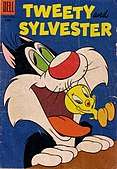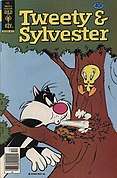Sylvester the Cat
Sylvester the Cat is a fictional character, an anthropomorphic tuxedo cat in the Looney Tunes and Merrie Melodies series of cartoons.[1] Most of his appearances have him often chasing Tweety, Speedy Gonzales, or Hippety Hopper. Sylvester appeared in 103 cartoons in the golden age of American animation, lagging only behind superstars Bugs Bunny, Porky Pig, and Daffy Duck.[2] Three of his cartoons won Academy Awards, the most for any starring Looney Tunes character: they are Tweetie Pie, Speedy Gonzales, and Birds Anonymous.
| Sylvester | |
|---|---|
| Looney Tunes character | |
 | |
| First appearance | Naughty but Mice (early version) May 20, 1939 Life with Feathers (official version) March 24, 1945 |
| Created by | Friz Freleng |
| Voiced by | Mel Blanc (1945–1989) Joe Alaskey (1990–2011) Jeff Bergman (1990–1993, 2007, 2011–present) Greg Burson (1993–1997) Bill Farmer (1996) Terry Klassen (2001–2006) Jeff Bennett (2003) Eric Bauza (2018) (see below) |
| In-universe information | |
| Full name | Sylvester Jackson Pussycat |
| Species | Cat |
| Gender | Male |
| Children | Sylvester Jr. (son) |
| Relatives | Sylth Vester (descendant) |
| Nationality | American |
Animation history
Development
Sylvester predecessors appeared from 1939–1944. Naughty but Mice was the first. Notes to You was remade in color in one of Sylvester's cartoons, Back Alley Oproar. The Hep Cat features another version, as well as Birdy and the Beast, which features Tweety. Before Sylvester's appearance in the cartoons, Blanc voiced a character named Sylvester on The Judy Canova Show using the voice that would eventually become associated with the cat.[3]
Personality and catchphrases
Sylvester shows a lot of pride in himself and never gives up. Despite (or perhaps because of) his pride and persistence, Sylvester is, with rare exceptions, placed squarely on the "loser" side of the Looney Tunes winner/loser hierarchy.
In many cartoons, Sylvester is shown intentionally sticking out his tongue while speaking, putting emphasis that the lisp is intentional. Sylvester is also known for spraying people he's talking to with the saliva from his lisping, which is a trait rarely shared by Daffy. A common gag used for both Sylvester and Daffy is a tendency to go on a long rant, complaining about a subject and then ending it by saying "sakes."
Sylvester's trademark exclamation is "Sufferin' succotash!", which is said to be a Minced oath of "Suffering Savior".
He shows a different personality when paired with Porky Pig in explorations of spooky places, in which he does not speak, behaves as a scaredy-cat, and always seems to see the scary things Porky does not see and gets scolded by him for it every time.
Sylvester, who for the most part always played the antagonist role, is featured playing the protagonist role in a couple of cartoons while having to deal with the canine duo of Spike the Bulldog and Chester the Terrier after being chased around. In 1952's Tree for Two by Friz Freleng, Sylvester is cornered in the back alley and this would result in Spike getting mauled by a black panther that had escaped from a zoo. In the 1954 film Dr. Jerkyl's Hide, Sylvester pummels Spike (here called "Alfie") thanks to a potion that transforms him into a feline monster. After Spike's ordeal, Sylvester would have the courage and confidence to confront Chester, only to be beaten and tossed away by the little dog.
Perhaps Sylvester's most developed role is in a series of Robert McKimson-directed shorts, in which the character is a hapless mouse-catching instructor to his dubious son, Sylvester Junior, with the "mouse" being a powerful baby kangaroo which he constantly mistakes for a "king-size mouse". His alternately confident and bewildered episodes bring his son to shame, while Sylvester himself is reduced to nervous breakdowns.
Sylvester also had atypical roles in a few cartoons:
- Kitty Kornered (1946), a Bob Clampett cartoon in which a black-nosed, yellow-eyed Sylvester was teamed with three other cats to oust owner Porky Pig from his house.
- Back Alley Oproar (1948), a Friz Freleng cartoon (actually a remake of the 1941 short Notes to You) wherein Sylvester pesters the sleep-deprived Elmer Fudd by performing several amazing musical numbers in the alley (and even a sweet lullaby ("go to sleep... go to sleep... close your big bloodshot eyes...") to temporarily ease Elmer back to the dream world, though very temporarily.
- The Scarlet Pumpernickel (1950), a Chuck Jones cartoon in which Sylvester plays the Basil Rathbone-like villain to Daffy Duck's Errol Flynn-esque hero.
- Red Riding Hoodwinked (1955) Sylvester co-stars with an absent-minded Big Bad Wolf in which each not only tries to get their particular "prey" (Sylvester vs. Tweety and the Wolf vs. Little Red Riding Hood) but they both nearly come to blows with each other playing "Grandma" ("Trying to muscle in on this racket")
In the television series Tiny Toon Adventures, Sylvester appeared as the mentor of Furrball. The character also starred in The Sylvester and Tweety Mysteries. In the series, he plays the narrator at the beginning of episodes.
Filmography
The character debuted in Friz Freleng's Life With Feathers (1945). Freleng's 1947 cartoon Tweetie Pie was the first pairing of Tweety with Sylvester, and the Bob Clampett-directed Kitty Kornered (1946) was Sylvester's first pairing with Porky Pig.
He also appears in a handful of cartoons with Elmer Fudd, such as a series of cartoons underwritten by the Alfred P. Sloan Foundation extolling the American economic system.
In the 1970s and 1980s, Sylvester appeared in various Warner Bros. television specials, and in the 1980s, he appeared in the feature-film compilations.
He has died more times than any other Looney Tunes character, having died in Peck Up Your Troubles, I Taw a Putty Tat, Back Alley Oproar, Mouse Mazurka, Bad Ol' Putty Tat, Ain't She Tweet, Satan's Waitin', Muzzle Tough, Sandy Claws, Tweety's Circus, Too Hop To Handle, Tree Cornered Tweety, Tweet and Lovely, Trick or Tweet, The Wild Chase, and Museum Scream. He was also cast in the role of the Jacob Marley-like ghost in Bah, Humduck! A Looney Tunes Christmas.
A baby version of Sylvester is part of the title cast of characters in Baby Looney Tunes.
Sylvester is featured in The Looney Tunes Show (2011–14) voiced by Jeff Bergman. He is shown living with Granny alongside Tweety. In "Point, Laser Point," it is revealed that Sylvester was attracted by a glowing red dot that was on his mother's necklace when he was young as experienced through hypnotic therapy done by Witch Lezah. It was also revealed that his mother (voiced by Estelle Harris) has retired to Florida (with Sylvester's mother being disappointed that Sylvester never kept wearing his retainer, never remembered where she lives in Florida, and has not caught Tweety yet). This episode also introduced Sylvester's brother Alan (voiced by Jeff Bennett).
Sylvester also makes recurring appearances in New Looney Tunes.
Cameo appearances
Sylvester appears in the Robot Chicken episode "Werewolf vs. Unicorn" voiced by Patrick Pinney. During Arnold Schwarzenegger’s announcement of illegal aliens from Mexico, Sylvester demonstrates a wired fence that will keep the aliens out, only for it to be penetrated by Speedy Gonzales.
Sylvester makes a cameo appearance in Who Framed Roger Rabbit, where he provides the punchline for a double-entendre joke regarding Judge Doom's (Christopher Lloyd) identity.
Sylvester appears as part of the TuneSquad team in Space Jam, bearing the number 9 on his jersey.
He also has two cameo appearances in Looney Tunes: Back in Action, but the second time, "Sylvester" is really Mr. Smith in disguise.
Other appearances
.jpg)
 Sylvester as emblem of the 45th Reconnaissance Squadron.
Sylvester as emblem of the 45th Reconnaissance Squadron. Sylvester as emblem of the 151st Fighter-Interceptor Squadron.
Sylvester as emblem of the 151st Fighter-Interceptor Squadron..jpg) Sylvester as seen in The Looney Tunes Show in this new design.
Sylvester as seen in The Looney Tunes Show in this new design. Sylvester in I Tawt I Taw a Puddy Tat
Sylvester in I Tawt I Taw a Puddy Tat
From 1979 to 1983, Sylvester was the "spokescat" for 9 Lives' line of dry cat food. His face appeared on the product's boxes and Sylvester was also featured in a series of television commercials. These ads usually consisted of Sylvester trying to get to his box of 9 Lives while avoiding Hector the Bulldog. Sylvester would always succeed in luring the dog away so he could get to his food, but would always find himself a target again by the end of the commercial, which generally ended with Sylvester calling 9 Lives dry food "worth riskin' your life for."
In the Family Guy episode Padre de Familia, Peter made up his American version of Speedy Gonzales called Rapid Dave after he decided that immigrants shouldn't be allowed into America. Sylvester (in which Jeff Bergman reprises his role) appeared in the cartoon with Dave that Peter made, and tried to catch him.
In The Simpsons episode Lisa's First Word, toddler Bart exclaims "Sufferin' succotash!" like Sylvester when Baby Lisa says her first word "Bart."
In 1985, Sylvester could be heard in an episode of the game show Press Your Luck. Host Peter Tomarken had earlier incorrectly credited his catchphrase "Suffering Succotash!" to Daffy Duck. Even though all three contestants had correctly answered "Sylvester," they were ruled incorrect. In a segment produced later and edited into the broadcast, Sylvester phoned Tomarken and told him, "Daffy Duck steals from me all the time." All three participants returned to compete in future episodes.
In comic books


Western Publications produced a comic book about Tweety and Sylvester entitled Tweety and Sylvester first in Dell Comics Four Color series #406, 489, and 524, then in their own title from Dell Comics (#4–37, 1954–62), and later from Gold Key Comics (#1–102, 1963–72). In most of the comic books, Sylvester has white fur surrounding his eyes, similar to Pepé Le Pew. The white fur disappeared in later comics.
Sylvester and Tweety appear in a DC Comics and Looney Tunes crossover comic called Catwoman/Tweety and Sylvester. In the issue, witches from the DC and Looney Tunes universe place a wager where the existence of all birds and cats (as well as bird and cat-themed heroes and villains) depends on if Sylvester can eat Tweety. Sylvester (designed more realistically for the DC Universe) teams up with Catwoman while Tweety teams up with Black Canary.[4]
In video games
Sylvester has appeared in the video games, Sylvester and Tweety in Cagey Capers, The Bugs Bunny Crazy Castle, The Bugs Bunny Birthday Blowout, Bugs Bunny Rabbit Rampage, Looney Tunes: Acme Arsenal, The Bugs Bunny Crazy Castle 2, Looney Tunes: Back in Action, Looney Tunes: Space Race, Bugs Bunny: Crazy Castle 3 and Sylvester and Tweety: Breakfast on the Run.
Naming
The name "Sylvester" is a play on Felis silvestris, the scientific name for the wild cat species (domestic cats like Sylvester are in the subspecies Felis silvestris catus). Sylvester was not named until Chuck Jones gave him the name Sylvester, which was first used in Scaredy Cat. Although the character was named Sylvester in later cartoon shorts (beginning with 1948's Scaredy Cat), he was called "Thomas" in his first appearance with Tweety in Tweetie Pie, most likely as a reference to a male cat being called a tom. Mel Blanc had also voiced a human character named Sylvester on Judy Canova's radio show earlier in the 1940s. Sylvester was officially given his name in the 1948 Chuck Jones short, Scaredy Cat.
Voice
Origin
Sylvester's trademark is his sloppy and yet stridulating lisp. In Mel Blanc's autobiography, That's Not All Folks! It's worth noting that Sylvester's voice is similar to Daffy Duck, only not sped up in post-production, plus the even more exaggerated slobbery lisp. Conventional wisdom is that Daffy's lisp, and hence also Sylvester's, were based on the lisp of producer Leon Schlesinger. However, Blanc made no such claim. He said that Daffy's lisp was based on him having a long beak and that he borrowed the voice for Sylvester.[5] He also said that Sylvester's voice was very much like his own, excluding the lisp (his son Noel Blanc has also confirmed this). In addition, director Bob Clampett, in a 1970 Funnyworld interview, agreed with Blanc's account concerning Schlesinger.[6]
Voice actors
- Mel Blanc (1945–1989); (I Tawt I Taw a Puddy Tat; archive audio)
- Jeff Bergman (Tiny Toon Adventures, Bugs Bunny's Overtures to Disaster, The Looney Tunes Show, Scooby Doo and Looney Tunes: Cartoon Universe, New Looney Tunes, Looney Tunes Dash, Family Guy, Looney Tunes Cartoons)
- Joe Alaskey (The Sylvester & Tweety Mysteries, Tiny Toon Adventures, Father of the Bird, Bah, Humduck! A Looney Tunes Christmas, Looney Tunes: Stranger Than Fiction, Carrotblanca, Looney Tunes: Reality Check, Looney Tunes: Back In Action, Tweety's High-Flying Adventure, TomTom Looney Tunes GPS,[7] Looney Tunes ClickN READ Phonics, various video games)
- Greg Burson (Looney Tunes B-Ball)
- Bill Farmer (Space Jam)
- Terry Klassen (Baby Looney Tunes)
- Jeff Bennett (Museum Scream)
- Eric Bauza (Looney Tunes: World of Mayhem)
- Patrick Pinney (Robot Chicken)
- Kevin Shinick (Mad)
Reception and legacy
Sylvester was #33 on TV Guide's list of top 50 best cartoon characters, together with Tweety.[8]
See also
References
| Wikimedia Commons has media related to Sylvester (Looney Tunes). |
- "Sylvester aka Sylvester J. Pussycat Sr. aka Puddy Tat". comicbookrealm. July 23, 2012.
- Lenburg, Jeff (1999). The Encyclopedia of Animated Cartoons. Checkmark Books. pp. 140–142. ISBN 0-8160-3831-7. Retrieved 6 June 2020.
- The Judy Canova Show, September 7, 1943, as rebroadcast on XM Radio's Old Time Radio channel August 13, 2008.
- Catwoman/Tweety and Sylvester #1
- Blanc, Mel; Bashe, Philip (1988). That's Not All, Folks!. Warner Books. ISBN 0-446-51244-3.
- An interview with Bob Clampett
- Eh, what's up, Doc? TomTom offers Looney Tunes voices for GPS navigators
Consumer Reports. September 27, 2010. Retrieved September 24, 2016. - "TV Guide's 50 greatest cartoon characters of all time". CNN. July 30, 2002.
External links
- Sylvester's history at Warner Bros' official website (requires flash).
- Sylvester Pussycat at Don Markstein's Toonopedia. Archived from the original on January 1, 2018.